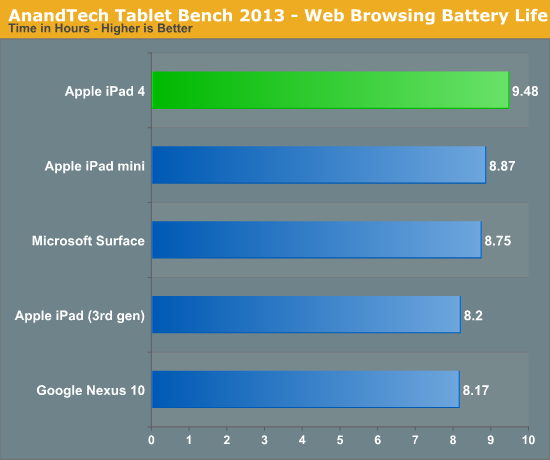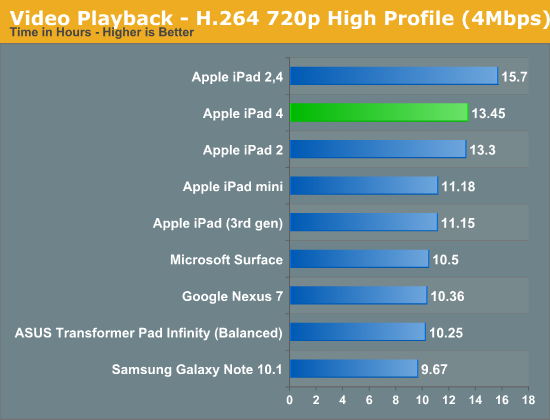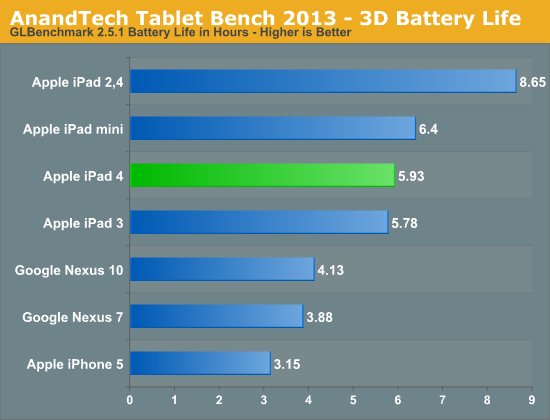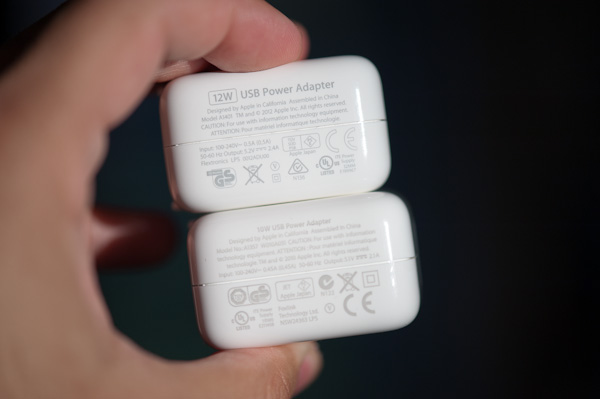iPad 4 (Late 2012) Review
by Anand Lal Shimpi on December 6, 2012 4:40 PM ESTCharging & Battery Life
The 4th gen iPad ships with a new 12W USB charger, a slight increase from the 10W model that shipped with all of the previous iPads. The new charger is no bigger than the previous version. Under max load the 12W charger will draw 13.57W at the wall. By comparison, the previous 10W model would pull a max of 12.44W. The 9% increase in power delivery does help shorten charge times a bit as it now only takes 5.69 hours for a complete charge (compared to ~6 with the old charger). It still takes a really long time to complete a full charge on the iPad, but without going to a larger power brick (or reducing the iPad's battery capacity) I don't see a simple solution here.

The iPad 4 is able to maintain charge equilibrium in the cases I tested, even under heavy load. With the 3rd generation iPad, if I ran Infinity Blade 2 while plugged in the total available battery charge would drop over time. On the 4th gen iPad, that no longer happens. I was able to maintain charge equilibrium even with the old 10W adapter on the iPad 4, pointing at overall power efficiency improvements rather than the new 12W adapter as the explanation for why this is now possible. It is possible that with fully loaded CPU and GPU cores that the new model wouldn't be able to maintain charge while powering the device, however I haven't encountered such a scenario yet.
Charge time isn't the only thing that improves with the 4th generation iPad. When Apple introduced the iPad 3, we saw a clear regression in battery life despite the much larger battery. I hate to sound like a broken record, but it's that same combination of power hungry display and big SoC that were responsible for the iPad 3's lower battery life. The iPad 4 doesn't ditch the display, but it does move to a 32nm LP HK+MG process for the SoC. Max power consumption should be higher thanks to the faster CPU/GPU cores, but given the same workload we should see a tangible improvement in battery life (similar to what we saw with the iPhone 5). We went through our standard suite of battery life tests to find out how things have changed since the iPad 3.
We've started running our new smartphone web browsing battery life test on tablets as well. If you missed its introduction in our iPhone 5 review, here's a bit about the new test:
We regularly load web pages at a fixed interval until the battery dies (all displays are calibrated to 200 nits as always). The differences between this test and our previous one boil down to the amount of network activity and CPU load.
On the network side, we've done a lot more to prevent aggressive browser caching of our web pages. Some caching is important otherwise you end up with a baseband/WiFi test, but it's clear what we had previously wasn't working. Brian made sure that despite the increased network load, the baseband/WiFi still have the opportunity to enter their idle states during the course of the benchmark.
We also increased CPU workload along two vectors: we decreased pause time between web page loads and we shifted to full desktop web pages, some of which are very js heavy. The end result is a CPU usage profile that mimics constant, heavy usage beyond just web browsing. Everything you do on your device ends up causing CPU usage peaks - opening applications, navigating around the OS and of course using apps themselves. Our 5th generation web browsing battery life test should map well to more types of mobile usage, not just idle content consumption of data from web pages.

I no longer have a 45nm iPad 2 so forgive me for the incomplete dataset here (it's safe to say that the iPad 2 would at least equal the iPad 4 in battery life, if not exceed it), but battery life has improved appreciably since earlier this year. The iPad 4 lasts around 15% longer on a single charge compared to the 3rd gen iPad. It also edges out the iPad mini and Microsoft's Surface. There's a good advantage over the Nexus 10 as well, but all of these tablets have smaller batteries than the iPad 4..
We haven't yet rerun our new test on all of the tablets, so we turn to our older 4th gen test to provide some additional reference points:

Here we see that although Apple has improved things, the iPad 4 still remains behind the old iPad 2's battery life target. Also note that in a lighter CPU workload where the iPad 4's Swift cores aren't asleep for substantially longer than the iPad 3's Cortex A9s, the difference in battery life ends up being pretty minimal.
Our video playback test remains unchanged from previous tablet reviews. Here I'm playing a 4Mbps H.264 High Profile 720p rip I made of the Harry Potter 8 Blu-ray. The full movie plays through and is looped until the battery dies. Once again, the displays are calibrated to 200 nits:

Video playback battery life has finally surpassed that of the iPad 2. As we saw with our camera analysis, Apple did some work on the video encode hardware/software this generation - it's also possible that the decode path saw an improvement as well. The 32nm iPad 2,4 still remains the king of this test but that's a bit of an anomaly. It's rare that we see a pure die shrink with no added performance/features offered these days.
Our final cross-platform battery life test is the new GLBenchmark 2.5.1 Egypt HD test. Here we have a loop of the Egypt HD benchmark, capped to 30 fps, running on all of the devices with their screens calibrated to 200 nits.

The results here actually surprised me a bit, but they make sense when you think about them. Capped at 30 fps (like many heavy iOS games are) the 4th generation iPad actually has GPU performance to spare in the Egypt HD test (avg frame rate is 40 fps vs. 21 fps for the iPad 3). Despite the fact that the 4th gen iPad has a more power hungry GPU, that extra performance remains partially unused which, when combined with the more power efficient 32nm LP process, gives the new iPad a slight edge in gaming battery life. Note that this only applies to the situation where the workload is identical between the iPad 3 and 4. Earlier I showed that some games actually put the increased shader power to good use and increase image quality. In these cases where the iPad 4 is doing more physical work than the iPad 3, you may see no improvement in battery life or even a regression.
Thermals
The display and backlight in the 3rd generation iPad, combined with the large 45nm SoC, resulted in a tablet that got pretty warm under load. The 4th gen model doesn't do away with the display but it does move to silicon that can drive to low power sleep states quicker than before (given the same workload). The result is a tablet that has the potential to run a bit cooler depending on what you're doing with it.
Under full load however there's no getting around the fact that both the CPU and GPU cores are significantly faster than their predecessor. Running Infinity Blade 2 for an hour produced slightly higher surface temperatures on the iPad 4 vs. the iPad 3:
| Thermal Comparison - iPad 3 vs. 4 - Infinity Blade 2 Loop (1hr) | ||||
| Temperature Measurement Location | Apple iPad 4 | Apple iPad 3 | ||
| Back of Tablet, Apple Logo | 35.7C | 34.4C | ||
| Back of Tablet, Hottest Point | 39.9C | 39.1C | ||
The difference isn't huge and it's only noticeable if you switch between the two tablets, but there's no real improvement in worst case thermals. The iPad 4 remains one of the warmest tablets that I've used. It doesn't get uncomfortably hot but I would prefer a cooler running device. Unfortunately until we see a big improvement in display power consumption, I just don't know how that will be possible. The move to 20nm won't happen anytime soon.











113 Comments
View All Comments
cheinonen - Thursday, December 6, 2012 - link
Color quality has always been a target, just not one that was possible for us to easily measure before. Now that we can, it's in almost every review. If that seems to favor Apple, that's only because other vendors refuse to care about it, and they aren't going to start caring until consumers understand and demand better.ltcommanderdata - Thursday, December 6, 2012 - link
It's not that pixel density is no longer important. It's that Apple has already satisfied people's needs for high pixel density. Most people already won't notice individual pixels on the iPad's 264 dpi display. So either Apple continues to improve pixel density for very little actual benefit, stops improving displays altogether, or they find another aspect of displays to improve. I think most people will be happy Apple choose the latter option and are improving color gamut and calibration.bplewis24 - Thursday, December 6, 2012 - link
I'm glad somebody else notices this. Taking a page straight out of Apple's Marketing dept.teiglin - Thursday, December 6, 2012 - link
Does Apple actually market their products this way? It's not like he's harping on it, but the S.S. Pixel Density set sail a year ago and all the high-end tablets are sufficient for most people (even the TF700, in my opinion--the steps from that to the iPad 4, then to the Nexus 10, are fairly incremental). Apple continues to differentiate its displays with proper calibration, and Anand is just pointing that out. As displays get better, it requires more attention to find the differences.The color accuracy on the Nexus 10 is objectively bad. I say this as someone who wants Google to step it up in this area--I have a Samsung tablet and my primary phone is HTC and have never owned an iPad or a Mac. Superior color accuracy isn't going to make me buy an iPad, but a dE over 8 on the Nexus 10 does make me think it's worth waiting for the generation of Google tablet.
bplewis24 - Thursday, December 6, 2012 - link
Check out their marketing materials and yes, even some of their commercials. When the coined the term "retina display" they immediately began publishing PPI measurements (and comparisons) in their marketing materials. The reason why this is significant is because other displays eventually caught up and surpassed in sheer resolution, but because the iPhone was smaller, the PPI measurement still stayed on top...even though, ironically, the benefits of such a high PPI and a much smaller display are harder to benefit from.cheinonen - Thursday, December 6, 2012 - link
The value of PPI has nothing to do with screen size, but distance relative to PPI. Just like an 84" 4K LCD has benefits if you sit 5' from it but no benefit if you are 25' from it compared to a same size 1080p display. The half-inch viewfinder of the camera I just bought has a 2.4 million dot OLED display. If that used the same PPI as a retina iPhone, with 3 dots per pixel, then that viewfinder would only have 0.2 million pixels and would certainly not be as sharp.However, as my eye is literally right next to that, a resolution way beyond 300 PPI is useful, despite the incredibly small size of the display. It's all about the distance relative to the PPI, not the size of the screen.
teiglin - Thursday, December 6, 2012 - link
I wasn't asking if they market PPI; I know that's the theme of the whole "retina" marketing. I was asking if they market the color accuracy and how their calibration is better than the competitors'. I've seem them mention the iPad's gamut (albeit briefly) but never its accuracy or calibration.EnzoFX - Thursday, December 6, 2012 - link
That's called avancement. The basis of technological progress. There Should always be something better to pursue. That is good for everyone. No matter how much your bias against Apple is.cheinonen - Thursday, December 6, 2012 - link
One more note on this. CalMAN 5 is used for measuring smartphones and tablets (and likely monitors in the future) since it supports measuring grayscale, gamut, saturations, and Gretag Macbeth charts, at any targets that we want, and with manual patterns instead of only internal pattern generators. Most solutions only allow for internal generators, which is why previous tablet and smartphone reviews (many of which were done well before Apple made a deal out of this) lack these charts as those programs don't run on an iOS or Android device.CalMAN 5 wasn't even released until September of this year, making most of these measurements impossible to do before then. So you can enjoy the conspiracy theories, but had these measurements been possible for me to do 18 months ago, I'd have done them 18 months ago.
JarredWalton - Friday, December 7, 2012 - link
On a related note, we've been discussing the importance of color accuracy on our LCD and laptop reviews for... oh, let's see... May of 2007.http://www.anandtech.com/show/2237
You'll notice that of all the laptop manufacturers, only Apple is consistently getting the display quality right (or at least, more right than others) for the MacBook Pro. And even that took a few years after my rant.